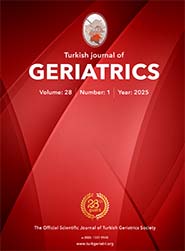2Ankara Etlik City Hospital, Ear Nose and Throat Clinic, Ankara, Turkey
3Ege University Faculty of Medicine, Department of Physical Medicine and Rehabilitation, Izmir, Turkey
4Izmir Bakircay University, Department of Audiology, Izmir, Turkey
5Ege University Faculty of Medicine, Department of Ear Nose and Throat , Izmir, Turkey DOI : 10.29400/tjgeri.2025.427 Introduction: The effects of aging on oculomotor functions and higherlevel cognitive processes are increasingly being investigated, and saccadic eye movements are considered an important tool to evaluate these changes related to aging. The aim of our study is to compare the random saccade and clinical saccadometry test parameters of healthy young and elderly participants.
Materials and Method: The study included two healthy adult groups, Group I (Young adults (18-30 years)) and Group II (Elderly adults (65-80 years)). Participants were administered random saccade test and prosaccade and antisaccade tests with the newly developed clinical saccadometry protocol, respectively.
Results: A total of 71 participants were included in the study, 37 in group I and 34 in group II. Random saccade latency in group I was determined to be significantly earlier compared to group II (p<0.05). Prosaccade and antisaccade latencies in group I were found to be earlier, while prosaccade and antisaccade directional error rates in group I was lower compared to group II (p<0.05). There was no significant difference between the groups in terms of velocity and accuracy parameters.
Conclusion: Our results suggest that age-related changes affect certain oculomotor functions, while some parameters remain stable in healthy aging. These findings enhance our understanding of oculomotor aging; however, further research is needed to assess their clinical relevance. Additionally, saccadometry may help elucidate cognitive and neural mechanisms in aging and serve as a potential tool for differential diagnosis.
Keywords : Saccade; Aging; Eye Movements; Cognition
